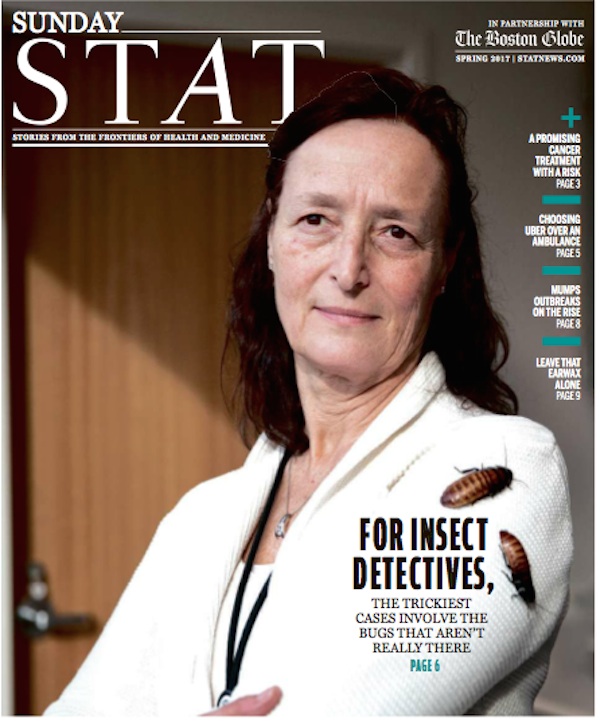Boston Globe-backed health news startup Stat is cracking the vertical media model

It’s hard to create a publication that’s specialized enough to command a premium price but interesting enough to a general audience. Stat, the medicine and health news site that The Boston Globe parent launched a year and a half ago, is starting to figure out how to make the model work.
Boston Globe Media Partners’ Stat launched a $299-a-year membership program about six months ago. It wouldn’t release hard numbers, but says it’s on its way to hit its goal of 10,000 subscribers in three years. Even after putting some of its content behind a pay wall, it’s expanded its audience. Stat sights internal analytics showing a high of 2 million users in March (its comScore number is a much-lower 761,000 unique visitors in April, which is typical of a small publication).
Boston Globe Media’s two earlier vertical launches haven’t gone as well. It closed Crux, focused on the Roman Catholic church, and ended BetaBoston as a standalone site.
While its pricing and benefits are similar to 3-year-old tech news outlet The Information, Stat is more like the Beltway news outlet Politico in that it’s trying to serve both professionals working in and around health care as well as the general public. Stat publishes about 15 new articles a day on average. About 10 percent of that content is available to members only (labeled Stat+), with the first group in mind. In addition to individual subs, it’s begun selling group subs to places like universities, pharmaceutical companies and health care providers, which can come with a discount of up to 45 percent. This means that going forward, the subscriber numbers may grow faster than the revenue.
To maximize its pool of potential subscribers and also build an ad business, Stat needs to attract a wider audience to its free content, though.
“We’re still building our audience, and we don’t want to scare off the general interest readers,” said Rick Berke, the executive editor of Stat.
To do that, Stat covers public health issues that are of interest to the public, like the EpiPen and opioids. Similarly, with events, it’s hoping that a partnership with The Atlantic for a daylong event in Boston will help draw premium subscribers, but others will be geared toward a wider audience, like one it had where science journalist Seth Mnookin talked about his experience with addiction.
As an additional audience (and advertising) builder, Stat has also begun publishing a print insert that’s distributed with the Sunday Globe. (Stat shares a building with the Globe but otherwise operates independently.) The first ran 12 pages and came out April 23; it’s set to publish quarterly.

“We see the benefit of free content in that it can draw people in and get them engaged with the brand, and over time if they see the pay wall if they don’t subscribe the first, second or third time, we have multiple times to keep them coming back,” said Stat’s chief revenue officer, Angus Macaulay. “If we were 10 or 15 years old, it might be different, but we’re still establishing ourselves with new readers.”
Figuring when, how much to charge and what to charge for are all questions that sub-based publishers have to figure out. Stat was relatively new when it put up the pay wall, so it wasn’t widely known, and has a small staff (30 editors and writers), which factored into how it thought about the price. (It’s on a par with The Information, which had a hard pay wall from the outset.)
While a Stat membership comes with other benefits like access to conference calls with reporters, a dedicated Slack channel and daily newsletter, it also didn’t want to charge too much more than existing health care trades and medical journals, some of which are free.
“We looked at where pricing is,” Macaulay said. “You can only put so many resources behind it. We’re new. People may not know enough about your brand. Our price point felt like the right place to start.”
Stat also got some help from the “Trump bump ,”with Trump trying to blow up Obamacare and attacking climate change science.
“Trump, for better or worse, is good for traffic,” Macaulay said. “It was incredibly encouraging to see continued traffic growth, despite the fact we had started to put content behind the pay wall.”
Publishers have had a boom in subscription growth as they’ve taken advantage of the public’s interest in Trump coverage to supplement their ad revenue, which made the timing of Stat’s pay wall fortuitous. (It also introduced a daily newsletter, Trump in 30 Seconds, about what the Trump presidency means for the health care industry and medical research; it has 15,000 subscribers.)
”There seems to be more of a willingness for people to pay for quality journalism these days, and I think we’re benefiting from it,” Berke said.
Image: Wikimedia
More in Media

Meta AI rolls out several enhancements across apps and websites with its newest Llama 3
Meta AI, which first debuted in September, also got a number of updates including ways to search for real-time information through integrations with Google and Bing.

Walmart rolls out a self-serve, supplier-driven insights connector
The retail giant paired its insights unit Luminate with Walmart Connect to help suppliers optimize for customer consumption, just in time for the holidays, explained the company’s CRO Seth Dallaire.

Research Briefing: BuzzFeed pivots business to AI media and tech as publishers increase use of AI
In this week’s Digiday+ Research Briefing, we examine BuzzFeed’s plans to pivot the business to an AI-driven tech and media company, how marketers’ use of X and ad spending has dropped dramatically, and how agency executives are fed up with Meta’s ad platform bugs and overcharges, as seen in recent data from Digiday+ Research.








